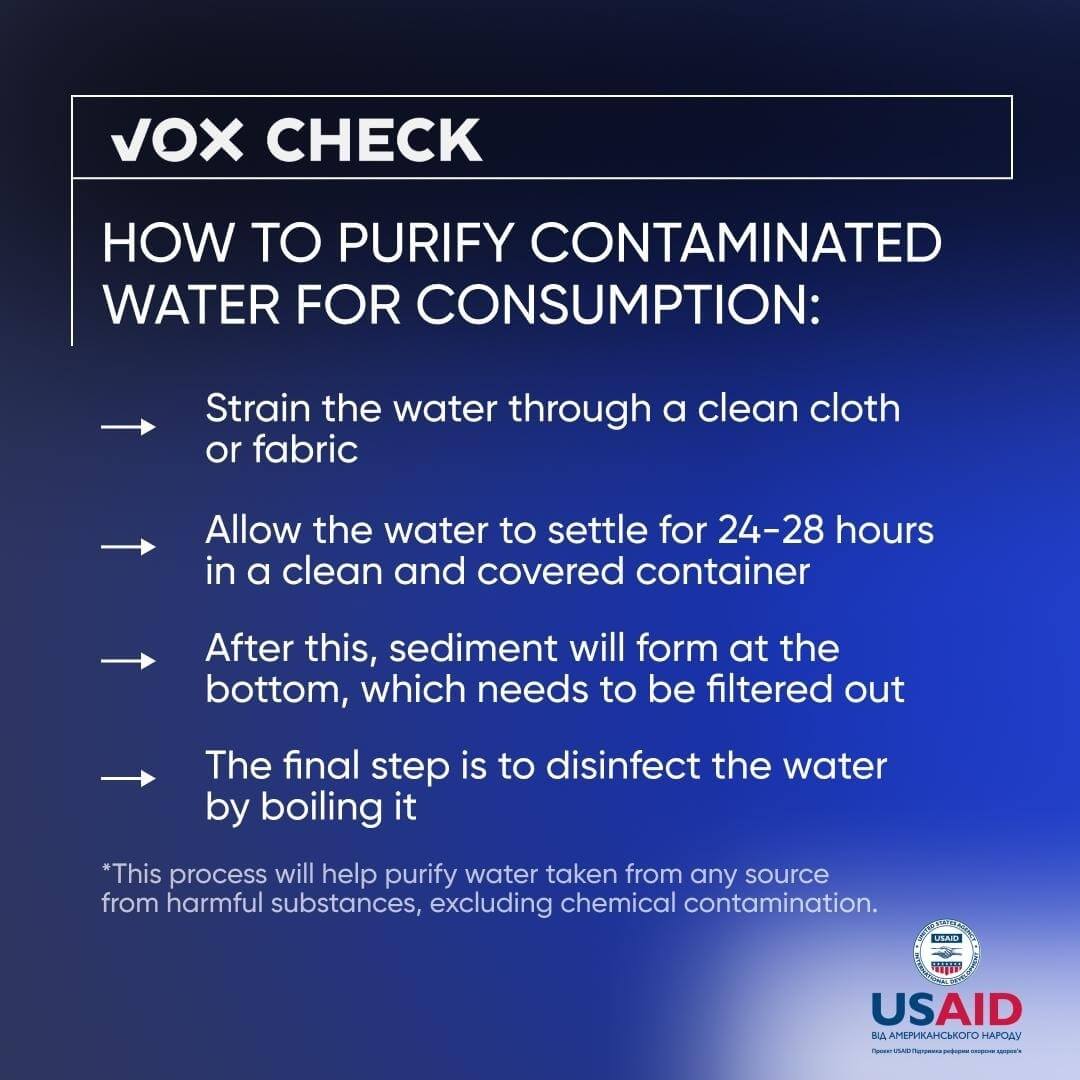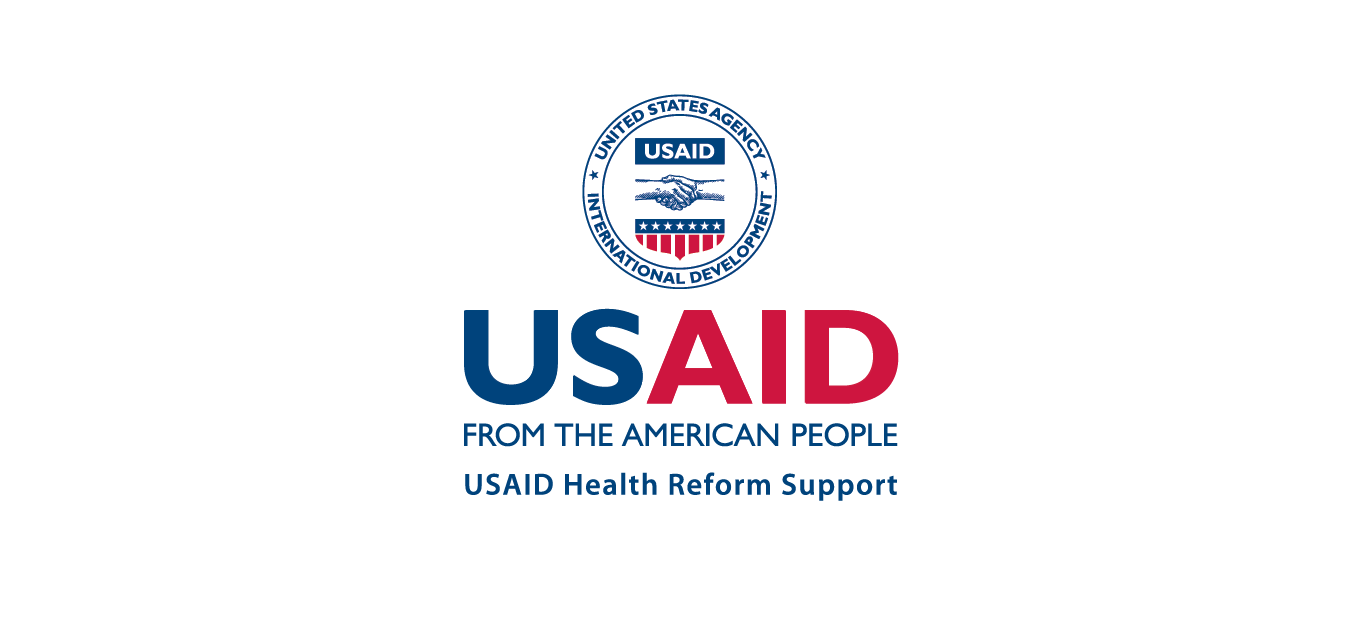After the blowing up of the Kakhovka Hydroelectric Power Plant, social media began spreading a false claim this year about a cholera outbreak in Kyiv or other cities in Ukraine. In addition, Russian collaborator Volodymyr Rogov saw the influence of the “Western hand” in Zaporizhzhia. He claims that American biological experiments and healthcare reform have led to an increase in tuberculosis cases in the Zaporizhzhia region.
With the support of the USAID Health Reform Support project, VoxCheck analyzes and refutes public health narratives spread in the information space of Ukraine, Belarus, and russia on a weekly basis.
Disinformation: In Kyiv, doctors are warning about a cholera outbreak
After the destruction of the Kakhovka Hydroelectric Power Plant, messages appeared on social media claiming that the chief physician of the Kyiv City Clinical Hospital of Emergency Medical Care had announced an upcoming cholera outbreak. However, in some posts, the specific city at risk of cholera is not mentioned.
What’s the reality?
Firstly, “Kyivvodokanal” has refuted the reports of a cholera outbreak. They have stated that the quality of drinking water is being monitored, and there are currently no deviations from state sanitary norms and regulations. Therefore, as of June 9, 2023, the tap water is considered safe. Additionally, “Kyivvodokanal” every day publishes updates on water quality in the capital city on their Facebook page.
The Ministry of Health of Ukraine acknowledges that during times of war, there is a risk of cholera spread due to the lack of proper sanitation conditions for people living in conflict zones. However, as of today, there are no confirmed cases of cholera in any region of Ukraine. Increased epidemiological surveillance is being implemented in the affected areas due to flooding, and the supply of necessary medicines is being increased. According to the Chief Sanitary Doctor, Ihor Kuzin, the situation regarding illnesses will become clearer once the water levels recede.
Secondly, posts with identical text about the supposed warnings from the chief physician were circulated back in June 2022 as well. The mentioned cities varied, including Kyiv, Odesa, Zaporizhzhia, and Kherson. The wave of fake news regarding the cholera outbreak was also observed in Russian media, where they claimed the threat was to Russian cities rather than Ukrainian ones.
A similar post about cholera in June 2022
Cholera is an acute infection that occurs due to the consumption of contaminated food or water containing a specific bacterium. Typically, cholera symptoms appear between 12 hours and 5 days after consuming contaminated food or water. Most individuals who contract cholera do not exhibit any symptoms, or if they do, they are usually mild to moderate. However, in some cases, severe acute watery diarrhea can occur.
The symptoms of cholera include watery diarrhea, vomiting, thirst, leg cramps, and irritability. To prevent cholera, it is advisable to follow a few guidelines:
- avoid purchasing food, especially fish, from places of street vending;
- refrain from swimming or fishing in polluted water;
- maintain personal hygiene;
- consume only clean water;
- wash vegetables and fruits before consumption.
To avoid the risk of infectious diseases in areas affected by the explosion of the HPP, it is important to have access to clean water. If you are in such areas and do not have bottled or delivered water, it is necessary to purify the contaminated water.
Source: Ministry of Health of Ukraine
Disinformation: Actions taken by the West have led to an increase in the number of tuberculosis cases in the Zaporizhzhia region
There is a statement circulated on social media by Russian collaborator Volodymyr Rogov, claiming that the number of tuberculosis cases has been increasing in the Zaporizhzhia region since 2016. He mentioned that this increase was due to American biological experiments, the closure of the bacteriological laboratory in Zaporizhzhia, the cancellation of tuberculosis diagnosis for children, and fluorographic screening, as well as the reform and optimization of tuberculosis care. Rogov added that due to these actions, 70% of patients have developed drug-resistant forms of tuberculosis.
What’s the reality?
According to the Center for Public Health, in the Zaporizhzhia region, the registration rate of new tuberculosis cases per 100,000 population decreased from 77 to 50.5 during the period from 2015 to 2021. Additionally, the number of new infections in the region decreased in 2022 to 33.5 cases per 100,000 population compared to 2021. However, the incidence of active tuberculosis in the first three months of 2023 increased by 13% compared to the same period in 2022.
Ihor Kuzin stated that the high level of tuberculosis incidence is attributed to insufficient vaccination coverage and delayed medical consultations. Ukraine is one of the nine countries in the world with the highest number of cases of multidrug-resistant tuberculosis. In 2022, multidrug-resistant tuberculosis was diagnosed for the first time in 119 patients in the Zaporizhzhia region. However, the high incidence of drug-resistant tuberculosis is not a result of Western actions, but rather a consequence of non-adherence to treatment regimens and an ineffective tuberculosis control system that existed in the past.
The Ministry of Health of Ukraine has explained that irregular medication intake or refusal of tuberculosis treatment can lead to the development of drug-resistant strains of the disease. As a result, the treatment duration is prolonged, and its effectiveness is reduced. Such patients can transmit drug-resistant forms of the infection to others, contributing to the emergence of the most unfavorable form of the disease.
Natalia Kozhan, a candidate in medical sciences and an honored doctor of Ukraine, has also stated that resistant forms of tuberculosis can arise due to cases of cross-infection within tuberculosis dispensaries. Therefore, in 2019, the Ukrainian government adopted the State Strategy for the Development of the Tuberculosis Medical Care System for the Population. The document included a transition from inpatient tuberculosis treatment to outpatient care.
In the Zaporizhzhia region, all tuberculosis facilities were supposed to be merged into a single regional tuberculosis institution. The number of inpatient beds has indeed been reduced because patients with mild forms of tuberculosis who regularly take medication cease to spread the disease within 2-3 weeks. In one of the previous episodes, we debunked the fake news about reforms in tuberculosis dispensaries.
In 2020, a phthisiopulmonological center was established in Zaporizhzhia based on the regional tuberculosis dispensary. Since 2007, there has been a third-level tuberculosis bacteriological laboratory in Zaporizhzhia, which conducts tuberculosis diagnostics.
Like in other regions of Ukraine, in Zaporizhzhia, the diagnosis of tuberculosis and medications for the treatment of various forms of the disease are provided free of charge. Patients receive medications at the phthisiatric office or from their family doctor.
Rogov’s statement about the cancellation of tuberculosis diagnosis is manipulative. The Mantoux test, which is performed to detect the tuberculosis pathogen, is mandatory for children who belong to risk groups, such as infants who have been in contact with infected individuals or have underlying conditions that weaken the immune system. The same approach is used for detecting tuberculosis in adults: chest X-ray examinations are conducted when there are symptoms of tuberculosis or for individuals in risk groups for tuberculosis. Additionally, since June 2022, a new diagnostic method for tuberculosis in children using the Xpert Ultra test has been implemented in Ukraine, which allows for more accurate detection of the disease and drug resistance to anti-tuberculosis medications.
This information piece was produced with the assistance of the United States Agency for International Development (USAID), provided on behalf of the people of the United States of America. This article’s content, which does not necessarily reflect the views of USAID, the United States Government, is the sole responsibility of Deloitte Consulting under contract #72012118C00001.
Attention
The authors do not work for, consult to, own shares in or receive funding from any company or organization that would benefit from this article, and have no relevant affiliations







